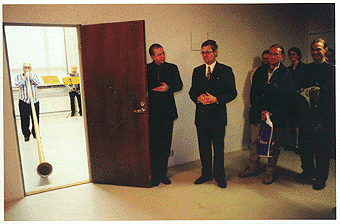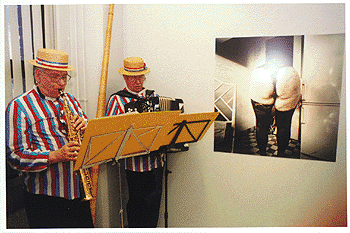
On display: 8.5.-13.6.1999

Opening of the exhibition by mr. Asko Mäkelä 7.5.1999
CHIPEX: Claude Cortinovis, Alan Humerose, Steeve Iuncker, Gérard Pétremand
They will present us a sensitive arrangement about the lost of bearings in public spaces and privacy, about urbanisation of human feelings.
In “Affinities” they have chosen to confront their views. On the world, the city, the object, the Other, them-selves. Thus, they have chosen to display their respective works in a continous arrangement. Should we now emphasize the differences between them? Or the parallels? In a certain sense, these photographies develop one common problematic which favours the associations of ideas in real life situations and singular moments, rather than a single type of reality. Hovering between what we hide and what is hidden, between what one sees and what one can not see any more, these pictures are situated at the edge between the private and the public, in an interface where meeting is possible, where cards are shuffled, where messages are deflected and intercepted, travelling from one point to the next.
For some of the photographers, the visible dimension of the real in the guise of objective, public space still needs to be revealed, since it is steeped in the banal. Street panels, advertisement, public signage, multiple indications, all merge in the urban clichés of Gérard Pétremand. Our eye is still able to sort things out, but generally we have ceased to notice the passive aggression that all these signs impose on the viewer. The space he presents is the street, a space designed for movement. The eye of the photographer does not impose a singular viewpoint or object. To the contrary, his almost absurd urban wanderings make us see a network filled with historical, social, esthetic and economic signs, which ironically yields an image deserted by meaning.
Avoiding a complacent fascination, Steeve Iuncker unveils imperfect bodies that amaze us, hovering between embarrassment and a feeling of tenderness. These bodies are not pleasent: they are marked by time, by singular histories, and evolve in a sinister setting. They perturb these images of smooth, young, dynamic bodies devoid of any asperities that society imposes as its ideal. We should not relate these photographies to pornography or to some deliberate attempt to undermine one's good taste, but, rather, to a kind of peacefull completion. One thinks of Boris Vian's, «all the dreadfulls will be killed», where the production of human models of a perfect beauty neutralizes all desires. Desire can only appear within difference, and in this particular case through confrontation of ugliness and impurity.
In daily life these objects are so minor that we do not notice them. But doormats aren't only thick and rough rugs on which we wipe our shoes. Taken up by decorative desires, they sometimes adress welcome messages to those who cross the doorstep: a threshold between the public and the private, between what is open and closed. But the goal of Alan Humerose is not to inform us on the socio-ethnic history of our pedestrian behaviour. His photographies do not expose reality, but divert and reconstruct it; constantly moving between the concreet and the abstract, the horizontal and the vertical, the appearance and the image. They curtail in this way the ridiculous preciousness of doormats, emphasizing their abstract form, undermining their meaning by titling them «Flag!», a word that can not possibly be emptied by its symbolic signification.
Photography (like painting) has entertained a durable complicity with the genre of self-portraiture. Still-life has doubtlessly inspired more painters than photographers. Claude Cortinovis, in a series of small prints, has endeavoured to connect the two genres. Each of his «photographic painting» results from a precise composition that associates his face and an object, introduces signs which refer to as many mental images, stows a composition which forms as well as colours. Being sensitive to material, light and scale, he uses self-representation to confront publicly his own image. By framing these small elliptic compositions very tightly, which are steeped in silence, he evokes nothing of his own life. Rather with a slight distance, he creates a dialogue between his different «selves»: the social self, the daily and the nocturnal self, the masked self. And always with a gently amused eye.
Françoise Nyffenegger-Ninghetto Translation: Fabrice Stroun April 1998

from the vernissage 7.5.1999